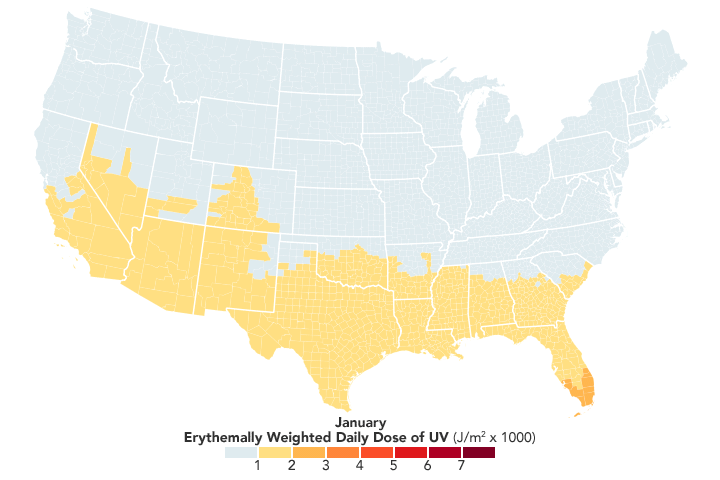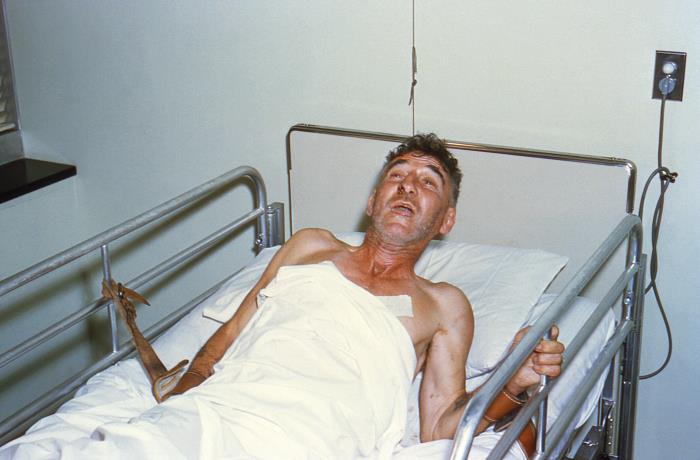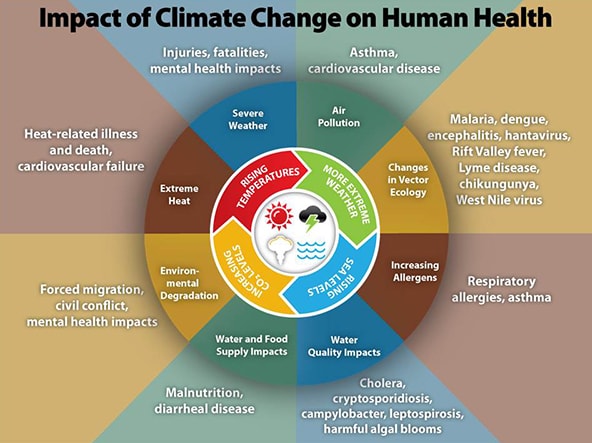Archive for August, 2019
NASA: New Map Shows Risk of Sunburn Across the U.S.
Thursday, August 8th, 2019
Skin cancer is the most common form of cancer in the United States, taking thousands of lives every year. By the age of 70, one in five Americans will develop skin cancer. Now NASA is helping public health officials track the primary cause of the disease: overexposure to ultraviolet radiation.
The NASA Applied Sciences Program has partnered with the Centers for Disease Control and Prevention (CDC) to create the first publicly available map of ultraviolet (UV) radiation for all counties in the contiguous United States. The dataset, which spans 2005-2015, is available on the CDC’s National Environmental Public Health Tracking network, which delivers information and data about health issues related to environmental factors. Public health officials, city planners, or individuals concerned about Sun exposure can learn how much ultraviolet radiation is falling over each county each month, which is an important step in helping reduce skin cancer risks.
“Before this, there hasn’t been a true comprehensive exposure measure of UV radiation,” said Yang Liu, an associate professor at Emory University’s Rollins School of Public Health. “People have been studying Sun exposure using very crude indicators. We’re looking at the specific UV wavelengths that can cause skin cancer.”
Although skin cancer is caused by ultraviolet radiation, different types of UV radiation can have different effects. The two that play an important role in skin cancer are UVA and UVB rays. UVA rays penetrate deeply into the skin to cause genetic damage to cells; UVA is linked to long-term skin damage such as wrinkles. UVB are the principal rays that cause sunburn and can directly damage the DNA in skin cells.
The maps on this page show the average amount of UV radiation per square meter reaching the surface in different parts of the country. Liu and his team used an equation to combine the various wavelengths of UV radiation to mimic the intensity of a sunburn—a measurement called the “erythemally weighted daily dose.” The researchers also gave more weight to more populated areas. For instance, the measurement is higher in more populated areas, which is helpful for studying the corresponding population health effects of high UV exposure.
MERS-CoV is known to spread more easily in healthcare settings
Thursday, August 8th, 2019“……Over the past year, a cluster of 61 cases in Wadi ad-Dawasir in February and March sickened 61 people, 14 of them health workers. The outbreak involved six healthcare facilities, and human-to-human spread occurred in two of them. Then in April, one of two unlinked clusters in Khafji resulted in 10 cases, 5 of them involving healthcare workers……
The main epidemiologic pattern for MERS-CoV (Middle East respiratory syndrome coronavirus) remains the same—many introductions from dromedary camels in the Middle East and secondary transmission in healthcare settings, the WHO said. Household transmission among close family members is still limited for unknown reasons, but healthcare-associated outbreaks in the region are occurring more often, are typically small, and can affect several hospitals…..”
How many victims after the Chernobyl disaster?
Thursday, August 8th, 2019https://www.youtube.com/watch?v=Xw3SFOfbR84
“…….Viktor Sushko, deputy director general of the National Research Centre for Radiation Medicine (NRCRM) based in Kiev, Ukraine, describes the Chernobyl disaster as the “largest anthropogenic disaster in the history of humankind”. The NRCRM estimate around five million citizens of the former USSR, including three million in Ukraine, have suffered as a result of Chernobyl, while in Belarus around 800,000 people were registered as being affected by radiation following the disaster.
Even now the Ukrainian government is paying benefits to 36,525 women who are considered to be widows of men who suffered as a result of the Chernobyl accident.
As of January 2018, 1.8 million people in Ukraine, including 377,589 children, had the status of victims of the disaster, according to Sushko and his colleagues. There has been a rapid increase in the number of people with disabilities among this population, rising from 40,106 in 1995 to 107,115 in 2018……..”

8/7/1998: A massive truck bomb explodes outside the U.S. embassy in Nairobi, Kenya and minutes later, another truck bomb explodes outside the U.S. embassy in Dar es Salaam, Tanzania, both resulting in 224 killed and over 4500 wounded.
Wednesday, August 7th, 2019A suicide car bomber targeted the police headquarters and the explosion resulted in dozens wounded
Wednesday, August 7th, 2019“…..Worldwide, about 59,000 people a year die from rabies, most in Africa and Asia, 99 percent of them because they were bitten by a rabid dog…..”
Wednesday, August 7th, 2019“…….Mission Rabies, which is part of Worldwide Veterinary Service and supported partly by Dogs Trust Worldwide, both nonprofits, has targeted Goa as a place to demonstrate the viability of its program to stop the spread of canine rabies. It spends about $300,000 a year and has vaccinated 100,000 dogs a year since 2017, about 50,000 a year before that. Deaths of people from rabies in Goa fell to zero last year from 15 in 2014, when the campaign started. There are none so far in 2019. ……”
CDC
C. auris may be the first example of a new fungal disease emerging from climate change
Tuesday, August 6th, 2019CDC video on Candida auris-2019
Tuesday, August 6th, 2019
Candida auris (C. auris) is an emerging fungus that presents a serious global health threat. CDC is concerned about C. auris for 3 main reasons:
- It is often multidrug-resistant, meaning multiple antifungal drugs are less or not at all effective in treating C. auris.
- It is difficult to identify with standard laboratory methods, and it can be misidentified in labs without specific technology. Misidentification may lead to inappropriate management.
- It has caused outbreaks in healthcare settings. It is important to quickly identify C. auris in a hospitalized patient so that healthcare facilities can take special precautions to stop its spread.
Most C. auris cases in the United States have been detected in the New York City area, New Jersey, and the Chicago area. Clusters of cases have also recently been described in Florida, Texas, and California. C. auris cases in the United States are originally a result of inadvertent introduction into the United States from a patient who had received healthcare in a country where C. auris has been reported. Most cases now are a result of local spread after such an introduction.





